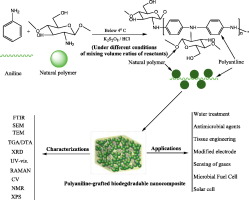Advances in Colloid and Interface Science ( IF 15.6 ) Pub Date : 2017-09-06 , DOI: 10.1016/j.cis.2017.08.006 Mohammad Shahadat , Mohammad Zain Khan , Parveen Fatemeh Rupani , Asha Embrandiri , Saima Sultana , Shaikh Ziauddin Ahammad , S. Wazed Ali , T.R. Sreekrishnan

|
Among the various electrically conducting polymers, polyaniline (PANI) has gained attentions due to its unique properties and doping chemistry. A number of electrically conducting biodegradable polymers has been synthesized by incorporating a biodegradable content of cellulose, chitin, chitosan, etc. in the matrix of PANI. The hybrid materials are also employed as photocatalysts, antibacterial agents, sensors, fuel cells and as materials in biomedical applications. Furthermore, these biodegradable and biocompatible conducting polymers are employed in tissue engineering, dental implants and targeted drug delivery. This review presents state of the art of PANI based biodegradable polymers along with their synthesis routes and unique applications in diverse fields. In future, the synthesis of PANI-grafted biodegradable nanocomposite material is expected to open innovative ways for their outstanding applications.
中文翻译:

对聚苯胺接枝的可生物降解纳米复合材料前景的批判性评论
在各种导电聚合物中,聚苯胺(PANI)由于其独特的性能和掺杂化学而备受关注。通过将可生物降解的纤维素,几丁质,壳聚糖等掺入PANI的基质中,已经合成了许多导电可生物降解的聚合物。杂化材料还用作光催化剂,抗菌剂,传感器,燃料电池以及生物医学应用中的材料。此外,这些可生物降解和生物相容性的导电聚合物被用于组织工程,牙科植入物和靶向药物递送中。这篇综述介绍了基于PANI的生物可降解聚合物的最新技术,以及它们的合成路线和在各个领域的独特应用。在未来,



























 京公网安备 11010802027423号
京公网安备 11010802027423号